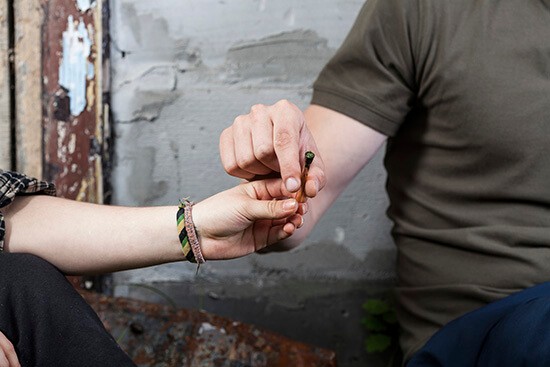Since 1996, when California became the first US state to legalize marijuana for medical use, concerns about a possible spike in the number of adolescents using the drug have arisen. Today, 23 states and the District of Columbia have laws legalizing marijuana in some form—five of them, Alaska, Colorado, Washington, Oregon, and DC, effectively permit recreational use by adults 21 and older.
Despite those initial concerns, the less restrictive landscape has not led to an increase in marijuana use by adolescents, according to a new study coauthored by BU School of Public Health researchers.
The study, published online in the journal Drug and Alcohol Dependence, found that marijuana use among American high school students is significantly lower today than it was 15 years ago. In 2013, 40.7 percent of high school students reported ever smoking marijuana, down from 47 percent in 1999. Because the rate had increased slightly since 2009, the researchers advise that “continued monitoring is necessary to observe how trends change over a longer period of time.”
SPH researchers Ziming Xuan, an assistant professor of community health sciences, and Emily Rothman, an associate professor of community health sciences, say the study shows that the legalization of medical marijuana, which began in 1996, has not led to a spike in use nationwide. They speculate that the lack of an increase could be the result of policy lag time, or might reflect the norms of youth culture in the places where marijuana has been legalized.
“We know little about how long it takes for the legalization of medical marijuana to affect use among youth. We have learned about a lag effect of policies from research on alcohol policies and youth drinking,” Xuan says. “So it could take considerable lag time for the effect of medical marijuana to manifest in youth use. The jury is still out.”
Rothman also says that it will take time to determine if the slight increase in use since 2009 is a statistical blip or the beginning of a trend. “It’s hard to know if we’re seeing a reversal of the steady decline in use, or if the results reflect some other factor,” she says. One possibility is that youth simply “feel more comfortable reporting their marijuana use on surveys now than they did in the past.”
The research team, led by Renee M. Johnson, a Johns Hopkins Bloomberg School of Public Health assistant professor, formerly with SPH, examined data from theNational Youth Risk Behavior Survey, a biennial school-based survey of students in grades 9 through 12, which gathers information from more than 115,000 adolescents throughout the United States. The researchers analyzed information from 1999 to 2013. The survey has been conducted by the US Centers for Disease Control and Prevention since 1990.
The study suggests that access to marijuana is not the main driver of use. National data from 2013 show that 70 percent of 10th graders and 81 percent of 12th graders say it would be fairly easy or very easy to obtain marijuana.
“A large portion of youth abstainers is likely doing so by choice, rather than because they lack access,” the authors say.
However, the study also found that marijuana use is significantly greater than the use of other illegal drugs. For example, just 3 percent of high school students reported that they had ever tried methamphetamines in 2013, and 5.5 percent said they had tried cocaine. Use of those other drugs also has declined since 1999, according to the study.
In addition to the decline in overall use, the study suggests that a gender gap in marijuana use—with boys outnumbering girls as users of the drug—is shrinking, and males and females are now using marijuana at similar rates. In 1999, 51 percent of boys and 43 percent of girls reported ever using marijuana, but by 2013, 42 percent of boys and 39 percent of girls said they had used it in their lifetime.
And while white and black teens once used marijuana at similar rates, blacks now report using the drug more often. The year 2013 marked the first time that the prevalence of current marijuana use (defined as use within the previous 30 days) among blacks was significantly higher than for whites—29 percent, compared to 20 percent.
“High levels of marijuana use among blacks, Hispanics, and American Indians deserve public health attention because these groups are more likely than whites to experience negative consequences of marijuana use, including CUDs (cannabis use disorders) and arrests,” the authors note.
Because overall rates of use crept up from 2009 to 2013, the researchers recommend continued monitoring of adolescent use to track trends and to identify new public health strategies for discouraging use.
Last week, a study in JAMA Psychiatry showed marijuana use among US adults had doubled in the past decade—from 4 percent in 2001–2002, to 9.5 percent in 2012–2013. The research, by the National Institute on Alcohol Abuse and Alcoholism, also showed that 3 out of every 10 Americans who used marijuana in the past year were classified as having a marijuana use disorder, meaning abuse or dependence on the drug.
Marijuana policy has undergone significant changes over the past 20 years. Since 1996, 34 states have passed legislation removing criminal sanctions for medical use of marijuana, and 11 states have passed laws decriminalizing possession of small amounts of marijuana, adding to the 9 that had passed such laws in the late 1970s.

